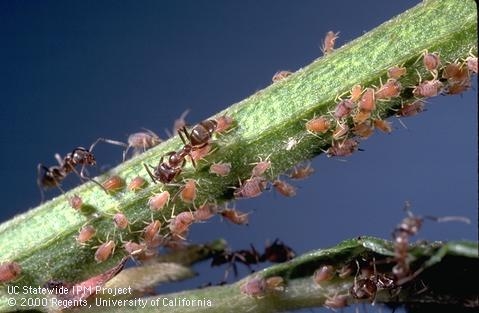Ants And Honeydew
By Linda Lewis Griffith UCCE Master Gardener
There are about 200 species of ants in California. The vast majority are harmless. In fact, many ants are considered beneficial because they feed on termites, fleas and other pests in the garden. But Argentine ants are one of the state's most serious ant pests, infesting homes, backyards and agricultural settings.
Argentine ants are dull brown in color. They move rapidly in long, distinct trails, usually travelling from their nests to a favored food source, such as honey, syrup, fruits or other sweets. In hot, dry weather, trails will also lead to water.
They live in shallow nests just below the surface of the soil. Colonies are linked together to form a large “supercolony” with multiple queens. When newly mated queens disperse to find new colonies, they are accompanied by workers from the existing colony, rather than going out on their own as most other species do.
Argentine ants are often found in trees and shrubs where they feed on honeydew excreted by small, soft-bodied, phloem-feeding insects, such as aphids, mealybugs, whiteflies, and soft scale. Honeydew is rich in sugar and a favorite food for the ants. The ants protect honeydew producing insects from natural enemies, allowing the pest population to increase and weaken the plant. Honeydew can also lead to sooty mold that blackens foliage, stems and fruit.
Ants can be kept out of trees by banding the trunks with a sticky substance, such as Tanglefoot. Circle the trunk securely with a collar of heavy paper, duct tape or fabric tree wrap. Then apply a layer of Tanglefoot completely around the collar. Inspect the coating every one or two weeks and reapply as necessary. Trim away branches that touch the ground, other plants or structures as these may provide other routes for ants to access the tree.
For more information on managing ants, go to: www.ipm.ucanr.edu/ants.
